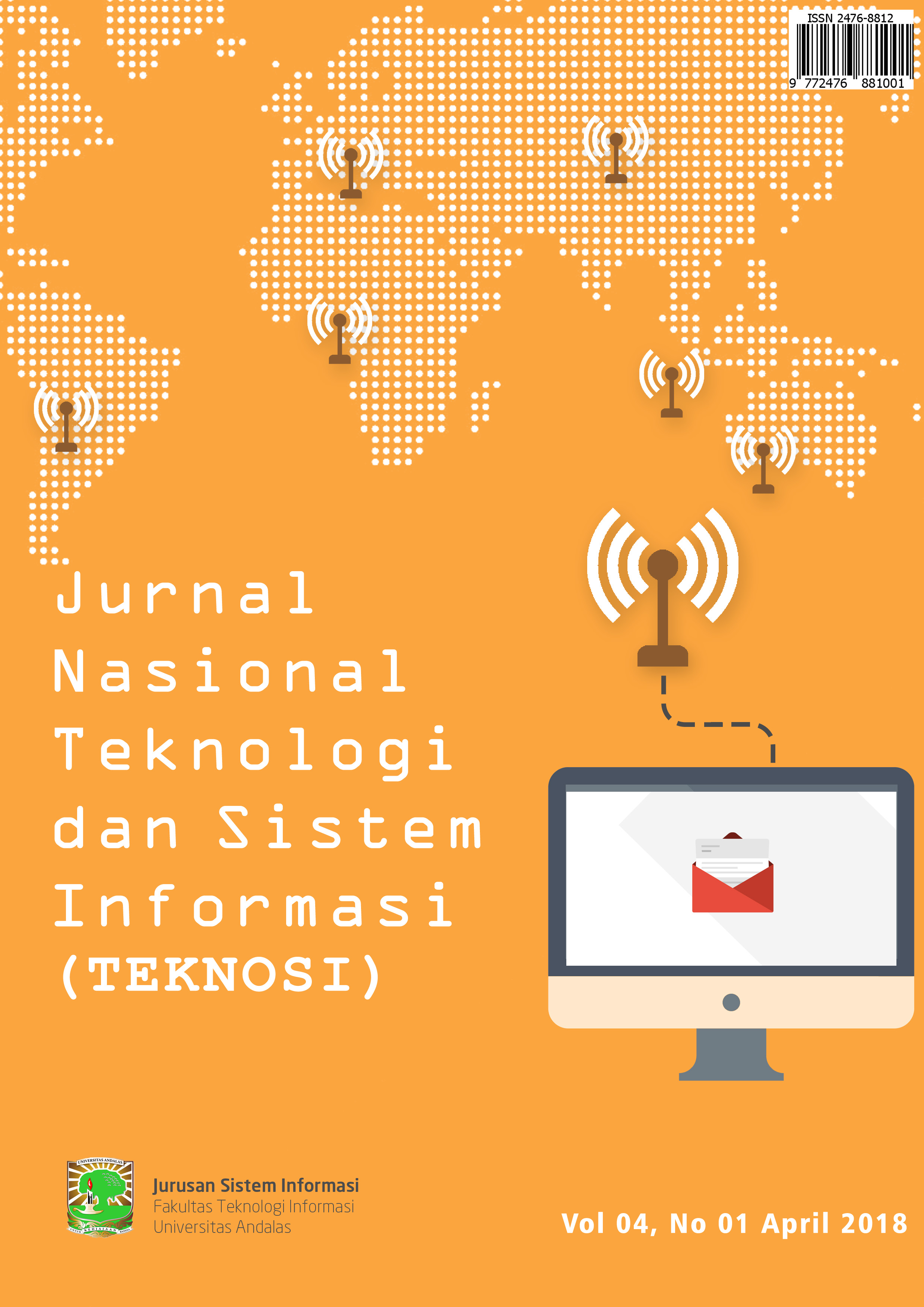Klasifikasi Rumah Tangga Miskin Menggunakan Ordinal Class Classifier
DOI:
https://doi.org/10.25077/TEKNOSI.v4i1.2018.30-36Kata Kunci:
Data Mining, Ordinal Class Classifier (OCC), KemiskinanAbstrak
The Central Bureau of Statistics of Indonesia (BPS) classified the target households into three different categories which were very poor households (RSTM), poor households (RTM), and nearly-poor households (RTSM). BPS need some method that can accelerate the classification process to assist the performance of BPS in order to shorten the processing time. The data scale that used in the classification of poor households was ordinal. Generally, calculations of classification using ordinal asscales only can be found in the software WEKA Ordinal Class Classifier (OCC) that was one of the existing classification in WEKA. OCC could be resolve to attributes that are nominal, numerical, and ordinal. So in this research, OCC would be using to classify poor households. By comparing the algorithms performance there were several stages that need to be traversed. The first was the data collection stage, the second was the data processing stage and information by using preprocessing, the third was the analysis stage with tools WEKA. The fourth was a test stage by counting the value of accuracy, precision, and recall. The last stage was evaluation by comparing actual data with predictive data of the result of calculating system. From the classification process, it can be concluded that OCC has the highest accuracy, precision, and recall level which is 90% (3803) of training set and 10% (423) of testing set with accuracy of 90.5437%, precision 0.919, and recall 0.905.Referensi
Ben David, A., Sterling, Leon., & Tran TriDat. (2009) Adding monotonicity to learning algorithms may impair their accuracy. Expert Systems with Application, 36, 6627-5534. Defiyanti S & dkk. (2016). Perbandingan Kinerja Algoritma ID3 dan C4.5 dalam Klasifikasi Spam-Mail. Han J, Kamber M. (2001). Data Mining : Concepts and Techniques. Simon Fraser University, Morgan Kaufmann Publishers. Inayah, Riza., & dkk. (2013). Klasifikasi Rumah Tangga Miskin di Kabupaten Jombang Berdasarkan Faktor-faktor yang Mempengaruhi dengan Pendekatan CART (Classification and Regression Trees). Jurnal Sains dan Seni Pomits, Vol.3, No.2, 2337-3520. Jhonpita, Phaiboon., & dkk. (2009). Ordinal Classification Method for the Evaluation of Thai Non-life Insurance Companies. Chulalongkorn University, Bangkok, Thailand Kantardzic, M. (2011). Data Mining, Concepts, Models, Methods, and Algorithms. IEEE Press, A john Wiley & Sons, Inc, Publication. Nugraha C, & dkk. (2016). Penerapan Metode Decision Tree(Data Mining) Untuk Memprediksi Tingkat Kelulusan Siswa Smpn1 Kintamani. Seminar Nasional Vokasi dan Teknologi (SEMNASVOKTEK). Denpasar-Bali, 22 Oktober 2016. Sugiyono. 2012. Metode Penelitian Kuantitatif Kualitatif dan R&D. Bandung: Alfabeta. Turban, et al., & dkk. (2007). Decision Support System and Intelligent System Seventh Edition. New Delhi: Prentice Hal World Bank Institute. 2002. Dasar-dasar Analisis Kemiskinan. Edisi Terjemahan. Badan Pusat Statistik, Jakarta.
Unduhan
Telah diserahkan
Diterima
Diterbitkan
Cara Mengutip
Terbitan
Bagian
Lisensi
Hak cipta untuk artikel ini ditransfer ke Jurnal Nasional Teknologi dan Sistem Informasi (TEKNOSI) jika dan ketika artikel diterima untuk publikasi. Yang bertanda tangan di bawah ini dengan ini mentransfer setiap dan semua hak di dalam dan ke kertas termasuk tanpa batasan semua hak cipta untuk TEKNOSI. Yang bertanda tangan di bawah ini dengan ini menyatakan dan menjamin bahwa makalah tersebut asli dan bahwa ia adalah pembuat makalah, kecuali untuk bahan yang secara jelas diidentifikasi sebagai sumber aslinya, dengan pemberitahuan izin dari pemilik hak cipta jika diperlukan. Yang bertanda tangan di bawah ini menyatakan bahwa ia memiliki kekuatan dan wewenang untuk membuat dan melaksanakan penugasan ini.
Kami menyatakan bahwa:
- Makalah ini belum diterbitkan dalam bentuk yang sama di tempat lain.
- Makalah ini tidak akan dikirimkan di tempat lain untuk publikasi sebelum penerimaan/penolakan oleh Jurnal ini
- Izin hak cipta diperoleh untuk materi yang diterbitkan di tempat lain dan yang memerlukan izin ini untuk reproduksi.
Selanjutnya, Saya/kami dengan ini mentransfer hak publikasi yang tidak terbatas dari makalah yang disebutkan di atas secara keseluruhan kepada TEKNOSI. Transfer hak cipta mencakup hak untuk mereproduksi dan mendistribusikan artikel, termasuk cetak ulang, terjemahan, reproduksi foto, mikroform, bentuk elektronik (offline, online) atau reproduksi lain yang serupa.
Penulis yang sesuai menandatangani dan menerima tanggung jawab untuk merilis materi ini atas nama setiap dan semua penulis bersama. Perjanjian ini harus ditandatangani oleh setidaknya salah satu penulis yang telah memperoleh persetujuan dari rekan penulis jika berlaku. Setelah pengajuan perjanjian ini ditandatangani oleh penulis yang sesuai, perubahan kepengarangan atau dalam urutan penulis yang tercantum tidak akan diterima.
Hak / Syarat dan Ketentuan yang dipertahankan :
- Penulis memiliki semua hak kepemilikan dalam setiap proses, prosedur, atau artikel manufaktur yang dijelaskan dalam Karya ini.
- Penulis dapat mereproduksi atau mengotorisasi orang lain untuk mereproduksi karya ini atau karya turunannya untuk penggunaan pribadi penulis atau untuk penggunaan perusahaan, dengan ketentuan bahwa sumber dan menyatakan hak cipta dimiliki TEKNOSI, salinan tidak digunakan dengan cara apa pun yang menyiratkan pengesahan TEKNOSI atas suatu produk atau layanan dari pihak mana pun, dan salinannya sendiri tidak ditawarkan untuk dijual.
- Meskipun penulis diizinkan untuk menggunakan kembali semua atau sebagian dari karya ini dalam karya lain, ini tidak termasuk mengabulkan permintaan pihak ketiga untuk mencetak ulang, menerbitkan ulang, atau jenis penggunaan ulang lainnya.














